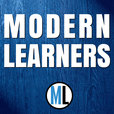
Summary: In this new podcast episode, Will and Bruce discuss the barriers to making change happen in schools.<br> <br> First, they reflect on the work they have done with school leaders recently. They often begin work with school leaders by asking the leaders to identify the barriers to school change. Before they get too far, it is important to define the school change Will and Bruce and the rest of the Modern Learners team is aiming to push. School change is not only about adding technology, Genius Hour, and Makerspaces. The change we support is change that moves agency over to the learners.<br> <br> Bruce took a guess as the barriers Will heard from leaders at his workshop a few days ago, and he divides the typical responses into two categories: compliance and hesitation on the part of faculty. Those two components were certainly shared by the leaders Will was working with in addition to parent expectations, higher education's traditional expectations, time, and budget.<br> <br> Will tells the story of asking the question, "Of all the barriers we talked about, how many of them are impossible to overcome?" The truth is none of those barriers are impossible to overcome. All of the barriers have been overcome somewhere.<br> <br> Bruce and Will are impressed with the change work in New Zealand schools. As a country, they are working to create the conditions necessary for modern learning. They have great examples.<br> <br> Bruce tells the story of leading two workshops within a couple of weeks of each other. One in Wellington and one in Aukland. Same workshop content. Same demographics. The people in Wellington approached the work with great breadth and depth. They had a sense of professional freedom. They had guidance but were encouraged to experiment. The people in Aukland were different. They said they can't make the changes being suggested. Why in one city within a country the people take on the work and in another city reject the work?<br> <br> Complacency -- people are in a place of comfort and familiarity, habit and tradition. That becomes harder to break out of. Culture can break barriers. The culture said you have the professional freedom to do what you know is best because you know what is best for kids.<br> <br> Doing different means putting everything on the table and examining it in the new contexts for learning. Obstacles are internal. We create external obstacles so that we don't have to work on the internal obstacles. It becomes a personal challenge and not a systems challenge. If we admit that we can't overcome an external obstacle, then we have to ask why aren't YOU overcoming the obstacles.<br> <br> The provocation for school change needs to come from leadership. Leaders foster attitudes and dispositions. Leaders influence school culture. School change will consist of 9 Cs (and we might add more as we continue to work with leaders in Change.School):<br> <br> Courage - This work is not easy.<br> Commitment - This work takes time.<br> Curiosity - This work requires us to ask lots of questions.<br> Conversation - This work demands discussion.<br> Confidence - This work is the right work.<br> Culture - This work creates positive cultures.<br> Clarity - This work is defined by our beliefs about learning and without them, we can't do the work.<br> Context - This work needs to embrace the modern world and the rate in which change is happening.<br> Consistency - This work means creating the conditions for learning and those conditions should not be starkly different from one classroom to the next.<br> <br> We must tell the new story of learning. Parents and communities understand school from the lens they looked through as a student. The world is changing and so is school. If we don't prepare our young people to meet the changing demands of the modern world, we will fail them.<br> <br> Change will not happen in schools until there ar...
